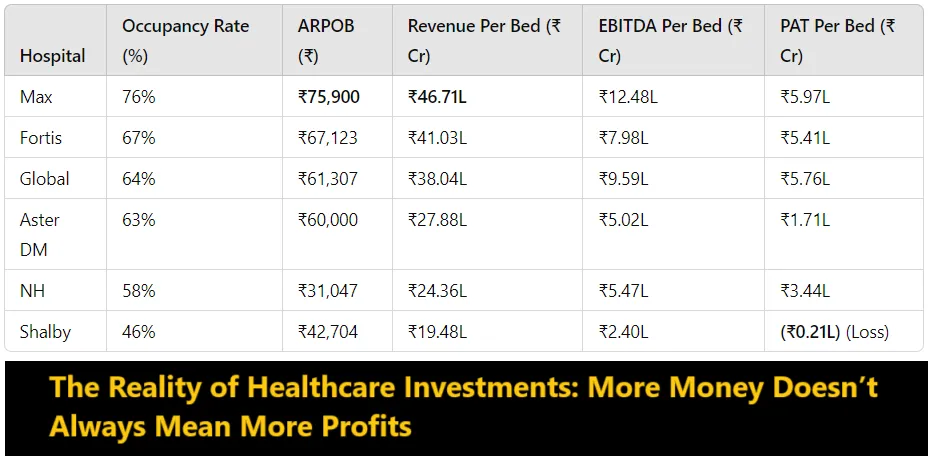
Indian Healthcare Investments Q3 FY25
The Reality of Healthcare Investments: More Money Doesn’t Always Mean More Profits
Hospitals are capital-intensive businesses, requiring massive investments in infrastructure, technology, and skilled professionals. But just pumping in money doesn’t guarantee high returns. How resources are optimized determines financial sustainability and patient care quality.
One of the most crucial factors in hospital profitability is bed utilization efficiency. More than just filling beds, it's about optimizing occupancy rates, case mix, and revenue generation per bed.
Let’s take a real-world look at hospital revenue and profitability per bed from Q3 FY25 data:
Hospital Occupancy Rate (%) ARPOB (₹) Revenue Per Bed (₹ Cr) EBITDA Per Bed (₹ Cr) PAT Per Bed (₹ Cr)
Max 76% ₹75,900 ₹46.71L ₹12.48L ₹5.97L
Fortis 67% ₹67,123 ₹41.03L ₹7.98L ₹5.41L
Global 64% ₹61,307 ₹38.04L ₹9.59L ₹5.76L
Aster DM 63% ₹60,000 ₹27.88L ₹5.02L ₹1.71L
NH 58% ₹31,047 ₹24.36L ₹5.47L ₹3.44L
Shalby 46% ₹42,704 ₹19.48L ₹2.40L (₹0.21L) (Loss)
🔎 Why is there such a huge difference?
Clearly, not all hospitals perform equally well despite having similar facilities. Some hospitals like Max and Fortis generate far higher revenue per bed than others like Shalby or NH, despite comparable occupancy rates.
So, what’s driving this gap?
📊 Key Factors That Influence a Hospital’s Profitability
✅ 1. ARPOB (Average Revenue Per Occupied Bed):
ARPOB isn't just about charging higher prices—it’s about service mix, specialized treatments, and operational efficiency.
Max & Fortis have higher ARPOB because they focus on high-end tertiary care & specialty surgeries.
NH, despite having more beds, generates lower revenue per bed due to a focus on affordable healthcare.
✅ 2. Bed Occupancy & Capacity Utilization:
A high occupancy rate (above 70%) is ideal. However, low efficiency in managing beds leads to financial strain.
Max (76% occupancy) vs. Shalby (46%) – More occupied beds = More revenue potential.
✅ 3. Cost of Generating ARPOB:
Revenue isn’t the only factor. The cost of maintaining hospital beds, staff salaries, technology, and medical supplies must be considered.
Even with high revenue per bed, if operational costs are too high, profits shrink.
✅ 4. Investment Per Bed & True ROI:
Simply building more hospital beds won’t guarantee better profits.
The return on investment (ROI) per bed depends on how effectively the bed is utilized.
Hospitals like Max & Fortis have optimized their high-end medical services, while others struggle with underutilization.
✅ 5. Case Mix – The Right Patient Profile Matters:
A hospital with high-end specialized treatments (cardiac surgery, oncology, organ transplants) will have higher profitability per bed compared to general care hospitals.
✅ 6. EBITDA & PAT – The Real Profitability Indicator:
Revenue is not the full story—it’s the earnings before interest, tax, depreciation, and amortization (EBITDA) and profit after tax (PAT) that show a hospital's true financial health.
Max (27% EBITDA) vs. Aster DM (18%)—indicating stronger financial sustainability.
🎯 The Key Takeaways: What Investors and Healthcare Leaders Must Focus On
🔹 Not all hospital investments yield the same returns—focus on smart utilization, not just expansion.
🔹 Occupancy rates matter, but efficiency & specialization define real profitability.
🔹 Revenue per bed is a critical metric—but must be balanced with cost efficiency.
🔹 Specialized high-end medical care drives long-term profitability.
🔹 True ROI isn’t about just adding more beds—it’s about how well they are used.
Healthcare investments are at an all-time high, but only hospitals that master efficiency, cost control, and high-end specialization will thrive.
Investors and healthcare administrators must look beyond the hype and optimize every bed’s revenue potential—because in the end, true healthcare success isn’t just about numbers, but about value-driven care.